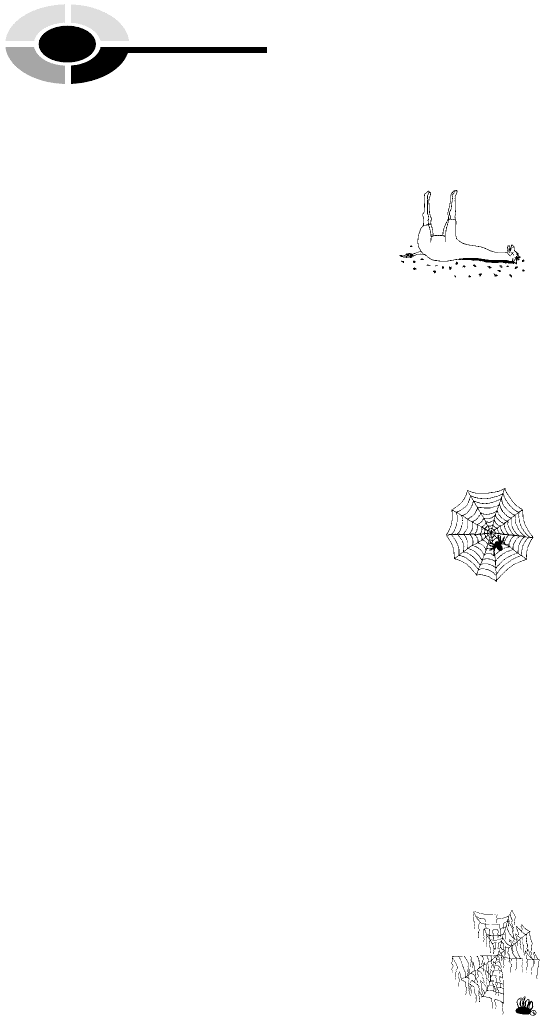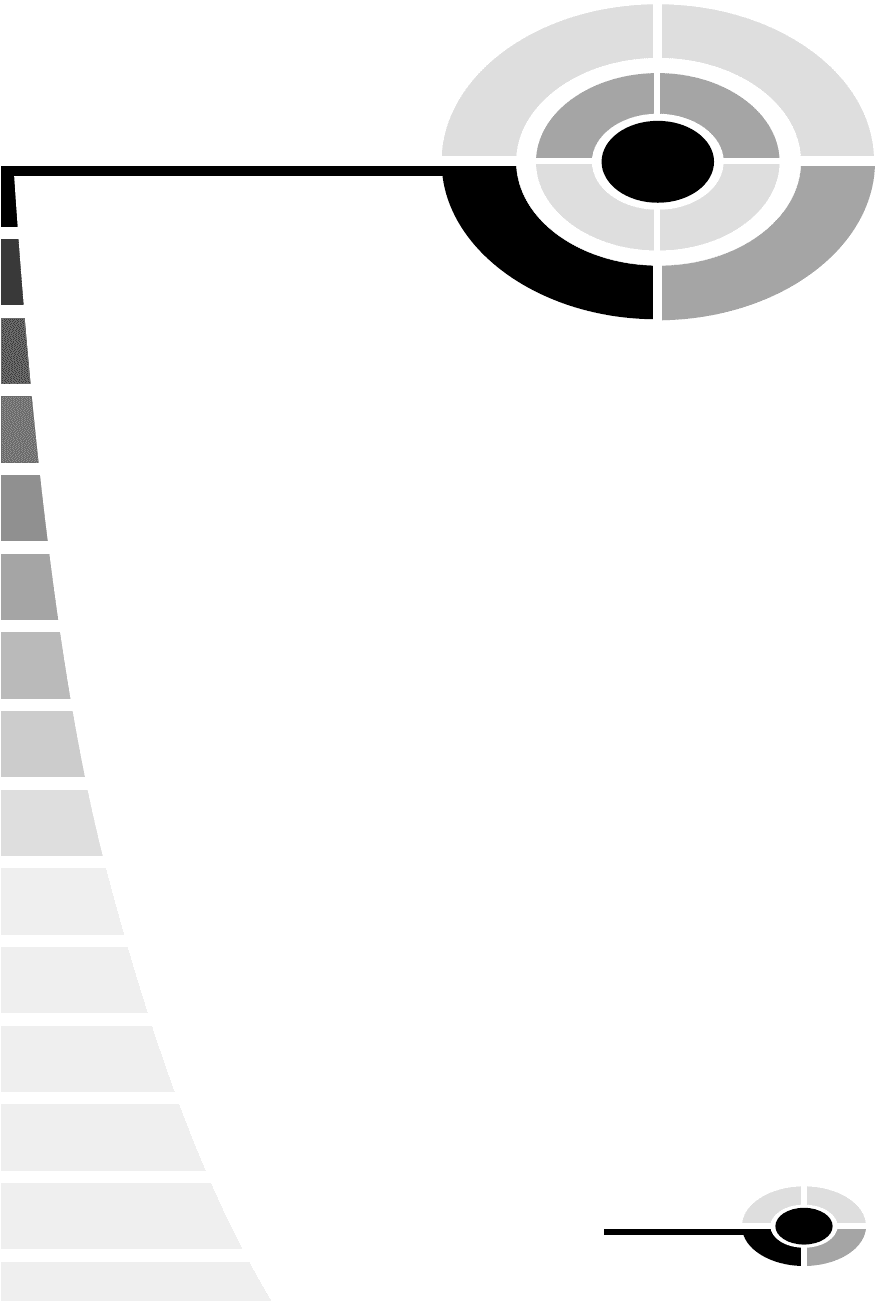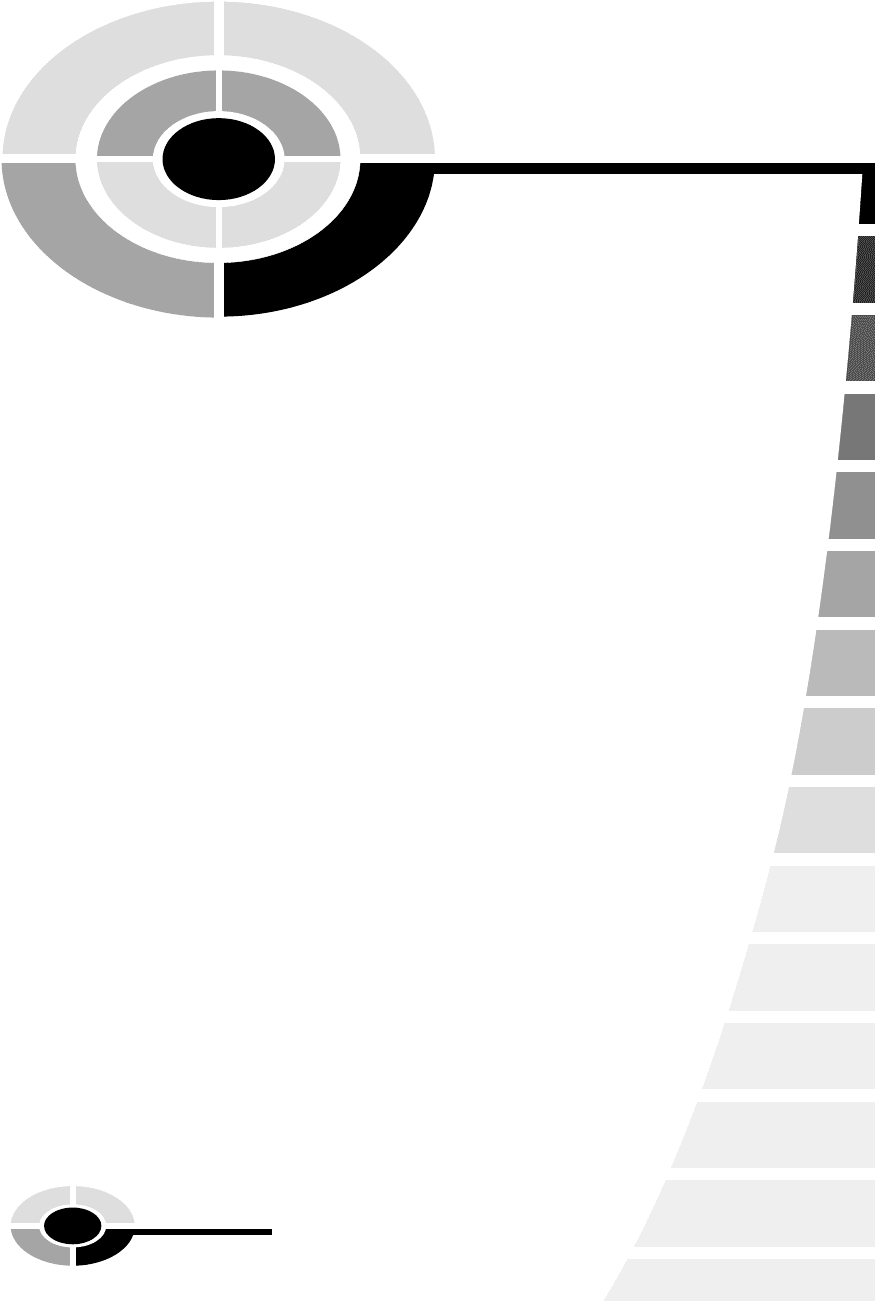Layman D. Biology Demystified: A Self-Teaching Guide
Подождите немного. Документ загружается.


prevented. The normal patterns of Biological Order leading to fertilization
are either interrupted or blocked.
MALE SEXUAL DYSFUNCTION
One important type of sexual dysfunction in males is infertility (in-fer-TILL-
ih-tee) – the inability to produce living spermatozoa that can fertilize an ovum.
One fairly common cause of infertility is cryptorchidism (krip-TOR-kid-ih-
zum). Cryptorchidism is a ‘‘condition of ’’ (-ism) ‘‘hidden’’ (crypt) ‘‘testes’’
(orchid). Cryptorchidism occurs when one or both of the testes fail to descend
out of the abdominal cavity, and into the scrotum. If such undescended testes
remain within the abdominal cavity for too long a period after birth, the high
internal body temperature may kill the germinal epithelium in the wall of the
seminiferous tubules. Thus, no fertile spermatozoa are produced.
FEMALE SEXUAL DYSFUNCTION
Females, too, can suffer from infertility, among many other types of possible
sexual dysfunctions. Female infertility is often due to either hypersecretion
(excessive secretion) or hyposecretion (deficient secretion) of particular hor-
mones. Consider, for example, the important hormone, thyroxine. Recollect
(Chapter 15) that thyroxine helps regulate the basal metabolic rate (BMR),
the rate at which body cells operate and burn calories under basal (resting)
conditions.
In hypothyroidism (HIGH-poh-THIGH-royd-izm), there is a ‘‘deficient or
below normal’’ (hypo-) activity of the thyroid gland. As a result, hyposecre-
tion of thyroxine slows down the metabolism of the female ovaries. When the
ovaries are seriously underactive, ovulation may be postponed or even
blocked. Female sterility is one unfortunate result.
Quiz
Refer to the text in this chapter if necessary. A good score is at least 8 correct
answers out of these 10 questions. The answers are listed in the back of this
book.
1. The reproductive organs are essentially the same thing as the _____
organs:
(a) Urinary
CHAPTER 20 Urine and Sex in Animals 357
[13:27 13/6/03 N:/4058 LAYMAN.751/4058-Alltext.3d] Ref: 4058 Layman: Biology Demystified All-text Page: 357 1-388
1, Disorder
2, Disorder

(b) Genital
(c) Digestive
(d) Musculoskeletal
2. The outermost zone of the kidney:
(a) Renal pelvis
(b) Adrenal medulla
(c) Renal cortex
(d) Glomerulus
3. The major microscopic functional unit of the kidney:
(a) Nephron
(b) Renal capsule
(c) Renal pyramid
(d) Collecting duct
4. A ring of voluntary striated muscle that allows us to consciously
control urination:
(a) Cardiac sphincter
(b) Cecum
(c) Glomerular ring structure
(d) Urinary sphincter
5. A tiny yarn-like ball of renal capillaries:
(a) Urinary tubule
(b) Renal pyramid
(c) Glomerulus
(d) Nephron
6. Fragmentation and regeneration is an example of:
(a) Urine formation in certain invertebrate animals
(b) Sexual reproduction in particular starfish and tunicates
(c) Embryo development in most types of fish
(d) A type of asexual reproduction
7. A female frog mounted by a male discharges her eggs into the water.
This process is part of:
(a) Internal fertilization
(b) Asexual reproduction
(c) External fertilization
(d) In vitro (test-tube) fertilization
[13:27 13/6/03 N:/4058 LAYMAN.751/4058-Alltext.3d] Ref: 4058 Layman: Biology Demystified All-text Page: 358 1-388
PART 4 Anatomy and Physiology of Animals
358

8. An eggshell-resembling structure that contains the seminiferous
tubules:
(a) Germinal epithelium
(b) Scrotum
(c) Epididymis
(d) Testis
9. The main mechanism of ejaculation in males:
(a) Gravity-influenced fall of spermatozoa from the penile orifice
(b) A simple diffusion of spermatozoa from a higher to lower
concentration
(c) Powerful contracting force of ductus deferens peristalsis pulls
sperm out of storage
(d) The epididymis explodes due to over-filling with sperm cells
10. A pair of slender egg ducts that carry ovulated ova towards the uterus:
(a) Fallopian tubes
(b) Peyer’s patches
(c) Ureters
(d) Seminal vesicles
The Giraffe ORDER TABLE for Chapter 20
(Key Text Facts About Biological Order Within An Organism)
1. ____________________________________________________________
2. ____________________________________________________________
3. ____________________________________________________________
4. ____________________________________________________________
5. ____________________________________________________________
CHAPTER 20 Urine and Sex in Animals 359
[13:27 13/6/03 N:/4058 LAYMAN.751/4058-Alltext.3d] Ref: 4058 Layman: Biology Demystified All-text Page: 359 1-388

The Dead Giraffe DISORDER TABLE for Chapter 20
(Key Text Facts About Biological Disorder Within An Organism)
1. ____________________________________________________________
2. ____________________________________________________________
The Spider Web ORDER TABLE for Chapter 20
(Key Text Facts About Biological Order Beyond the Individual Organism)
1. ____________________________________________________________
2. ____________________________________________________________
3. ____________________________________________________________
4. ____________________________________________________________
5. ____________________________________________________________
The Broken Spider Web DISORDER TABLE for Chapter 20
(Key Text Facts About Biological Disorder Beyond the Individual
Organism)
1. ____________________________________________________________
[13:27 13/6/03 N:/4058 LAYMAN.751/4058-Alltext.3d] Ref: 4058 Layman: Biology Demystified All-text Page: 360 1-388
PART 4 Anatomy and Physiology of Animals
360

[13:27 13/6/03 N:/4058 LAYMAN.751/4058-Alltext.3d] Ref: 4058 Layman: Biology Demystified All-text Page: 361 1-388
361
Test: Part 4
DO NOT REFER TO THE TEXT WHEN TAKING THIS TEST. A good
score is at least 18 (out of 25 questions) correct. Answers are in the back of
the book. It’s best to have a friend check your score the first time, so you
won’t memorize the answers if you want to take the test again.
1. The skin and skeleton can be legitimately studied together because:
(a) They both arise from two neighboring germ layers in the embryo
(b) Each is composed of hard bony tissue
(c) Neither is the exact opposite of the other
(d) Organ systems never die
(e) Oftentimes both types of systems are missing in late embryos
2. Substance mainly responsible for waterproofing human skin:
(a) Keratin
(b) Melanin
(c) Glycogen
(d) Albumen
(e) Chlorophyll
3. Possess an endoskeleton comprised of bone and joint connective tissue:
(a) Most arthropods
(b) Some crabs
Copyright 2003 by The McGraw-Hill Companies, Inc. Click Here for Terms of Use.

(c) A few types of fish, only
(d) Most spiders
(e) Humans and most other vertebrates
4. Maintenance of blood calcium homeostasis is important because:
(a) Ca
þþ
is essential for all enzyme function
(b) Bone matrix cannot store many calcium ions
(c) Contractions of all body muscles depend upon an adequate supply
of blood Ca
þþ
(d) Homeostasis can never be violated
(e) People’s bones are easily fractured when there is too much body
calcium
5. Within a bone–muscle lever system, the _____ usually serves as the
fulcrum:
(a) Tendon
(b) Joint
(c) Synovial membrane
(d) Ligament
(e) Bursa
6. Perimysium is located where within a skeletal muscle organ?
(a) Around each fascicle of muscle fibers
(b) Lying upon the entire muscle organ
(c) Within each bundle or fascicle of fibers
(d) Between fascicles, but within the muscle organ
(e) Neither within nor outside of muscle fiber fascicles
7. According to the sliding filament theory, muscle fibers contract because:
(a) Thin actin myofilaments slide inward over tilted myosin cross-
bridges
(b) Thick myosin myofilaments become longer, causing the actin to
shorten
(c) Myofibrils pile upon one another, somewhat like an accordion
(d) Thick myosin myofilaments slide outward over vertical actin cross-
bridges
(e) Muscle proteins are progressively destroyed and digested
8. Spinal nerves and individual peripheral nerves are considered parts of
the:
(a) CNS
(b) Spinal cord
(c) Cerebrum
[13:27 13/6/03 N:/4058 LAYMAN.751/4058-Alltext.3d] Ref: 4058 Layman: Biology Demystified All-text Page: 362 1-388
PART 4 Anatomy and Physiology of Animals
362

[13:27 13/6/03 N:/4058 LAYMAN.751/4058-Alltext.3d] Ref: 4058 Layman: Biology Demystified All-text Page: 363 1-388
PART 4 Test 363
(d) PNS
(e) Neuromuscular junction
9. Sensory receptors are specialized nerve endings that are sensitive to a
particular kind of:
(a) Thought impulse
(b) Stimulus
(c) ACh molecule
(d) Motor impulse
(e) Higher motor neuron
10. Exocrine glands:
(a) Are without ducts
(b) Secrete major hormone products
(c) Depend upon ducts to carry their secretions
(d) Release messengers into the bloodstream
(e) Include the thyroid and anterior pituitary
11. Releasing hormones are:
(a) Secreted into the bloodstream by special neurons in the
hypothalamus
(b) Sent into a system of ducts
(c) Produced by epithelial cells within the posterior pituitary gland
(d) Modified by the adrenal cortex before they are actually secreted
(e) Named for their direct influence upon the thyroid gland
12. Follicle-stimulating hormone (FSH) primarily acts to:
(a) Release insulin into the bloodstream
(b) Enhance the development of ovarian follicles and their secretion of
estrogen and progesterone
(c) Rupture the mature ovarian follicles, resulting in ovulation
(d) Decrease the rate of secretion of growth hormone (GH)
(e) Reduce the symptoms of tissue inflammation
13. Helps the adrenal medulla carry out the ‘‘Fight-or-Flight’’ stress
response:
(a) Corpus luteum
(b) Secondary sex characteristic
(c) Sympathetic portion of the nervous system
(d) The structure of the progesterone molecule
(e) A calm, serene, mental attitude
14. An alternate name for the cardiovascular system:
(a) Respiratory network
(b) Pituitary stalk

(c) Circulatory system
(d) Endocrine system
(e) Integumentary system
15. The tiniest blood vessels:
(a) Capillaries
(b) Veins
(c) Arterioles
(d) Arteries
(e) Venules
16. Have a two-chambered heart with only a single circulation:
(a) Fish
(b) Amphibians
(c) Reptiles
(d) Humans
(e) All other mammals besides humans
17. The contraction and emptying phase of each heart chamber:
(a) Systole
(b) ‘‘Dupp’’
(c) Diastole
(d) Cardiac cycle
(e) ‘‘Lubb’’
18. A below normal or ‘‘deficient’’ blood pressure:
(a) Normotension
(b) Arteriosclerotic heart disease
(c) Hypotension
(d) Atherosclerosis
(e) Hypertension
19. Closely associated with immunity:
(a) Human exoskeleton
(b) Digestive tract
(c) Lymphatic and reticuloendothelial system
(d) Nodal tissue
(e) Myocardium
20. External respiration occurs between the blood in the _____ and the air
in the _____:
(a) Systemic arterioles; pulmonary capillaries
[13:27 13/6/03 N:/4058 LAYMAN.751/4058-Alltext.3d] Ref: 4058 Layman: Biology Demystified All-text Page: 364 1-388
PART 4 Anatomy and Physiology of Animals
364

(b) Pulmonary capillaries; alveoli
(c) Pulmonary arteries; alveoli
(d) Bronchi; trachea
(e) Systemic capillaries; bronchioles
21. Fish respiration differs from that in land-dwelling animals in that they:
(a) Extract much more oxygen from the surrounding air
(b) Have a better defense mechanism to protect wet breathing surfaces
from dehydration
(c) Utilize H
2
O as a source for both obtaining O
2
and excreting CO
2
(d) Take advantage of the lungs as a mechanism for ventilation
(e) Possess five lungs, instead of just two
22. A flexible flap of cartilage forming the lid over the voice box:
(a) Epiglottis
(b) Primary bronchus
(c) Glottis
(d) Thyroid cartilage
(e) Laryngeal prominence
23. Digestion:
(a) The movement of food from the pharynx into the esophagus
(b) A type of peristalsis found in the human stomach
(c) Essentially the same thing as caloric balance
(d) The chemical and physical breakdown of food
(e) Passage of nutrients across the wall of the digestive tube, into the
blood
24. Consists of the duodenum plus the jejunum plus the ileum:
(a) Small intestine
(b) Colon
(c) Cecum
(d) Vermiform appendix
(e) Rectum
25. In humans, the stage of development from the third month after
fertilization:
(a) Blastula
(b) Embryo
(c) Yolk sac
(d) Fetus
(e) Zygote
[13:27 13/6/03 N:/4058 LAYMAN.751/4058-Alltext.3d] Ref: 4058 Layman: Biology Demystified All-text Page: 365 1-388
PART 4 Test 365

[13:27 13/6/03 N:/4058 LAYMAN.751/4058-Alltext.3d] Ref: 4058 Layman: Biology Demystified All-text Page: 366 1-388
366
Final Exam
DO NOT REFER TO THE TEXT WHEN TAKING THIS EXAM. A good
score is at least 75 correct. Answers are in the back of the book. It’s best to
have a friend check your score the first time, so you won’t memorize the
answers if you want to take the test again.
1. Modern biology is literally the
(a) ‘‘Removal of organisms’’
(b) ‘‘Study of life’’
(c) ‘‘Examination of objects under the microscope’’
(d) ‘‘Study of Nature’’
(e) ‘‘Love of knowledge’’
2. Biological Order essentially represents
(a) Very organized patterns seen in living things
(b) Too much chaos in the affairs of Nature
(c) The exact opposite of Body Organization
(d) Contradictory things to different human observers
(e) A deficiency of regular arrangements between body parts
3. The head, neck, and black spots of a giraffe
(a) Microbial physiology
(b) Simple structures
Copyright 2003 by The McGraw-Hill Companies, Inc. Click Here for Terms of Use.
